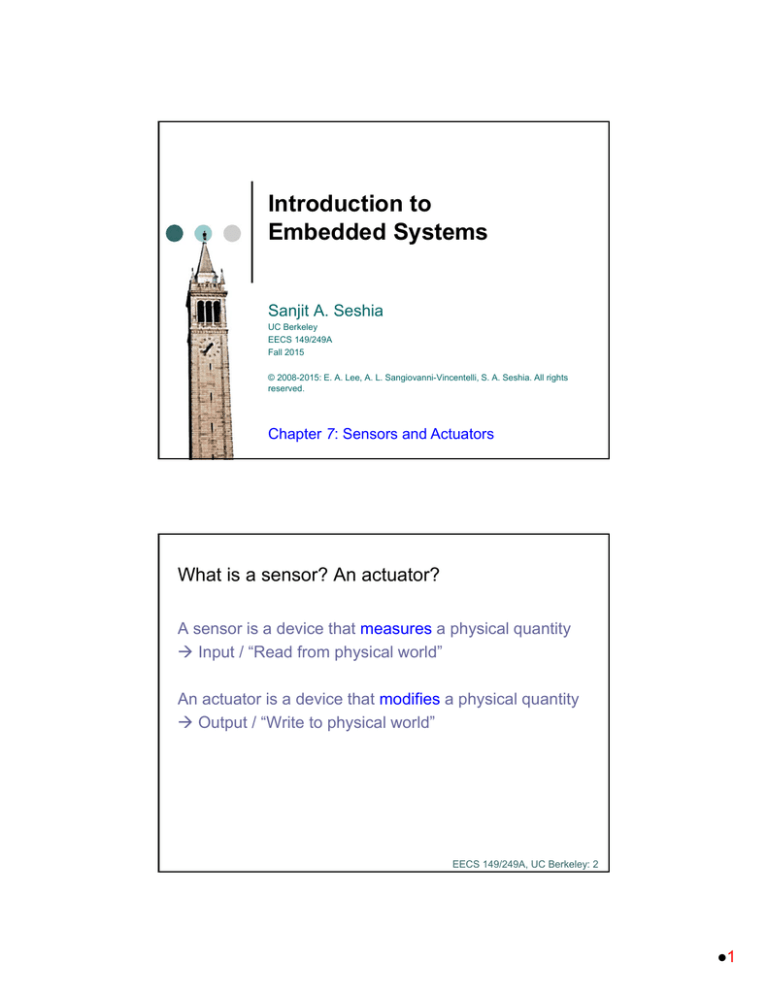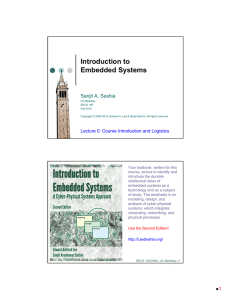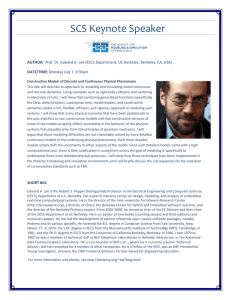
Introduction to
Embedded Systems
Sanjit A. Seshia
UC Berkeley
EECS 149/249A
Fall 2015
© 2008-2015: E. A. Lee, A. L. Sangiovanni-Vincentelli, S. A. Seshia. All rights
reserved.
Chapter 7: Sensors and Actuators
What is a sensor? An actuator?
A sensor is a device that measures a physical quantity
Input / “Read from physical world”
An actuator is a device that modifies a physical quantity
Output / “Write to physical world”
EECS 149/249A, UC Berkeley: 2
1
Sensors and Actuators – The Bridge between the
Cyber and the Physical
Actuators:
Sensors:
Cameras
Accelerometers
Gyroscopes
Strain gauges
Microphones
Magnetometers
Radar/Lidar
Chemical sensors
Pressure sensors
Switches
…
Motor controllers
Solenoids
LEDs, lasers
LCD and plasma displays
Loudspeakers
Switches
Valves
…
Modeling Issues:
Physical dynamics
Noise
Bias
Sampling
Interactions
Faults
…
EECS 149/249A, UC Berkeley: 3
Self-Driving Cars
x
Berkeley PATH Project Demo,
1999, San Diego.
Google self-driving car 2.0
EECS 149/249A, UC Berkeley: 4
2
Kingvale Blower
Berkeley PATH Project, March, 2005
EECS 149/249A, UC Berkeley: 5
Sensor-Rich Cars
Source: Analog Devices
EECS 149/249A, UC Berkeley: 6
3
Sensor-Rich Cars
Source: Wired Magazine
EECS 149/249A, UC Berkeley: 7
Kingvale Blower: Technology Overview
Berkeley PATH Project, March, 2003
EECS 149/249A, UC Berkeley: 8
4
Magnetometers
A very common type is the Hall
Effect magnetometer.
Charge particles (electrons, 1)
flow through a conductor (2)
serving as a Hall sensor.
Magnets (3) induce a magnetic
field (4) that causes the
charged particles to
accumulate on one side of the
Hall sensor, inducing a
measurable voltage difference
from top to bottom.
The four drawings at the right
illustrate electron paths under
different current and magnetic
field polarities.
Edwin Hall discovered this effect in 1879.
Image source: Wikipedia Commons
EECS 149/249A, UC Berkeley: 9
Roadmap for Lecture
How Accelerometers work
Affine Model of Sensors
Bias and Sensitivity
Faults in Sensors
Brief Overview of Actuators
EECS 149/249A, UC Berkeley: 10
5
Accelerometers
The most common design measures the distance
between a plate fixed to the platform and one
attached by a spring and damper. The measurement
is typically done by measuring capacitance.
Uses:
Navigation
Orientation
Drop detection
Image stabilization
Airbag systems
EECS 149/249A, UC Berkeley: 11
Spring-Mass-Damper Accelerometer
By Newton’s second law,
F=ma.
For example, F could be the
Earth’s gravitational force.
The force is balanced by the
restoring force of the spring.
EECS 149/249A, UC Berkeley: 12
6
Spring-Mass-Damper System
x
Exercise: Convert to an integral equation with initial conditions.
EECS 149/249A, UC Berkeley: 13
Measuring tilt
EECS 149/249A, UC Berkeley: 14
7
Difficulties Using Accelerometers
Separating tilt from acceleration
Vibration
Nonlinearities in the spring or damper
Integrating twice to get position: Drift
Position is the integral of
velocity, which is the integral
of acceleration. Bias in the
measurement of acceleration
causes position estimate
error to increase quadraticly.
EECS 149/249A, UC Berkeley: 15
Inertial Navigation Systems
Dead reckoning
plus GPS.
Combinations of:
GPS (for initialization and periodic correction).
Three axis gyroscope measures orientation.
Three axis accelerometer, double integrated for
position after correction for orientation.
Typical drift for systems used in aircraft have to be:
0.6 nautical miles per hour
tenths of a degree per hour
Good enough? It depends on the application!
EECS 149/249A, UC Berkeley: 16
8
Design Issues with Sensors
Calibration
Nonlinearity
Measurements may not be proportional to physical phenomenon
Correction may be required
Feedback can be used to keep operating point in the linear region
Sampling
Relating measurements to the physical phenomenon
Can dramatically increase manufacturing costs
Aliasing
Missed events
Noise
Analog signal conditioning
Digital filtering
Introduces latency
EECS 149/249A, UC Berkeley: 17
Material to be covered on blackboard
Affine Sensor Model
Bias and Sensitivity
Example: Look at ADXL330 accelerometer datasheet
EECS 149/249A, UC Berkeley: 18
9
EECS 149/249A, UC Berkeley: 19
EECS 149/249A, UC Berkeley: 20
10
Faults in Sensors
Sensors are physical devices
Like all physical devices, they suffer wear and tear, and
can have manufacturing defects
Cannot assume that all sensors on a system will work
correctly at all times
Solution: Use redundancy
However, must be careful how you use it!
EECS 149/249A, UC Berkeley: 21
Violent Pitching of Qantas Flight 72 (VH-QPA)
An Airbus A330 en-route from Singapore to Perth on 7
October 2008
• Started pitching violently, unrestrained passengers hit
the ceiling, 12 serious injuries, so counts as an
accident
• Three Angle Of Attack (AOA) sensors, one on left (#1),
two on right (#2, #3) of airplane nose
• Want to get a consensus good value
• Have to deal with inaccuracies, different positions,
gusts/spikes, failures
[J. Rushby]
EECS 149/249A, UC Berkeley: 22
11
A330 AOA Sensor Processing
Sampled at 20Hz
Compare each sensor to the median of the three
If difference is larger than some threshold for more than 1
second, flag as faulty and ignore for remainder of flight
Assuming all three are OK, use mean of #1 and #2 (because
they are on different sides)
If the difference between #1 or #2 and the median is larger than
some (presumably smaller) threshold, use previous average
value for 1.2 seconds
Failure scenario: two spikes in #1, first shorter than 1 second,
second still present 1.2 seconds after detection of first
Result: flight control computers commanding a nose-down
aircraft movement, which resulted in the aircraft pitching down to
a maximum of about 8.5 degrees
[J. Rushby]
EECS 149/249A, UC Berkeley: 23
How to deal with Sensor Errors
Difficult Problem, still research to be done
Possible approach: Intelligent sensor communicates an
interval, not a point value
• Width of interval indicates confidence, health of sensor
[J. Rushby]
EECS 149/249A, UC Berkeley: 24
12
Sensor Fusion: Marzullo’s Algorithm
Axiom: if sensor is nonfaulty, its interval contains the true
value
Observation: true value must be in overlap of nonfaulty
intervals
Consensus (fused) Interval to tolerate f faults in n:
Choose interval that contains all overlaps of n − f; i.e., from
least value contained in n − f intervals to largest value
contained in n − f
Eliminating faulty samples: separate problem, not needed
for fusing, but any sample disjoint from the fused interval
must be faulty
[J. Rushby]
EECS 149/249A, UC Berkeley: 25
Example: 4 Interval Sensor Readings
[J. Rushby]
EECS 149/249A, UC Berkeley: 26
13
Example: Marzullo’s Fusion Interval
[J. Rushby]
EECS 149/249A, UC Berkeley: 27
Example: Marzullo’s Approach does not satisfy
Lipshitz Condition
[J. Rushby]
EECS 149/249A, UC Berkeley: 28
14
Schmid’s Fusion Method
Recall: n sensors, at most f faulty
Choose interval from f+1st largest lower bound to f+1st
smallest upper bound
Optimal among selections that satisfy Lipschitz
Condition
[J. Rushby]
EECS 149/249A, UC Berkeley: 29
Example: Schmid’s Interval satisfies Lipshitz
Condition
[J. Rushby]
EECS 149/249A, UC Berkeley: 30
15
Motor Controllers
Bionic hand from Touch Bionics
costs $18,500, has and five DC
motors, can grab a paper cup
without crushing it, and turn a key
in a lock. It is controlled by nerve
impulses of the user’s arm,
combined with autonomous
control to adapt to the shape of
whatever it is grasping. Source:
IEEE Spectrum, Oct. 2007.
EECS 149/249A, UC Berkeley: 31
Pulse-Width
Modulation (PWM)
Delivering power to
actuators can be
challenging. If the
device tolerates rapid
on-off controls (“bangbang” control), then
delivering power
becomes much easier.
Duty cycle around 10%
EECS 149/249A, UC Berkeley: 32
16
Model of a Motor
Back electromagnetic
force constant
Electrical Model:
Angular velocity
Mechanical Model (angular version of Newton’s second
law):
Moment of
inertia
Torque
constant
Friction
Load
torque
EECS 149/249A, UC Berkeley: 33
Summary for Lecture
Overview of Sensors and Actuators
How Accelerometers work
Affine Model of Sensors
Bias and Sensitivity
Faults in Sensors
Brief Overview of Actuators
EECS 149/249A, UC Berkeley: 34
17
Extra Slides Follow
EECS 149/249A, UC Berkeley: 35
Feedback dramatically improves accuracy and
dynamic range of microaccelerometers.
The Berkeley Sensor and
Actuator Center (BSAC)
created the first silicon
microaccelerometers, MEMS
devices now used in airbag
systems, computer games,
disk drives (drop sensors), etc.
V/F
Digital
T
+
-
M. A. Lemkin, “Micro Accelerometer
Design with Digital Feedback Control”,
Ph.D. dissertation, EECS, University of
California, Berkeley, Fall 1997
EECS 149/249A, UC Berkeley: 36
18
Measuring Changes in Orientation:
Gyroscopes
Optical gyros: Leverage the Sagnac effect, where a laser light is sent
around a loop in opposite directions and the interference is measured.
When the loop is rotating, the distance the light travels in one direction is
smaller than the distance in the other. This shows up as a change in the
interference.
Images from the Wikipedia Commons
EECS 149/249A, UC Berkeley: 37
Strain Gauges
Mechanical strain gauge used to measure the
growth of a crack in a masonry foundation. This
one is installed on the Hudson-Athens
Lighthouse. Photo by Roy Smith, used with
permission.
Images from the Wikipedia Commons
EECS 149/249A, UC Berkeley: 38
19
Aliasing
Sampled data is
vulnerable to aliasing,
where high frequency
components
masquerade as low
frequency
components.
Careful modeling of
the signal sources
and analog signal
conditioning or digital
oversampling are
necessary to counter
the effect.
A high frequency sinusoid sampled at a low rate looks
just like a low frequency sinusoid.
Digitally sampled images are vulnerable to aliasing as
well, where patterns and edges appear as a side effect of
the sampling. Optical blurring of the image prior to
sampling avoids aliasing, since blurring is spatial lowpass filtering.
EECS 149/249A, UC Berkeley: 39
Noise & Signal Conditioning
Example:
|Xd () |2
|Xn () |2
Filter:
F ()
Filtered signal:
|Xd () F () |2
|Xn () F () |2
A full treatement of
this requires random
processes.
EECS 149/249A, UC Berkeley: 40
20




